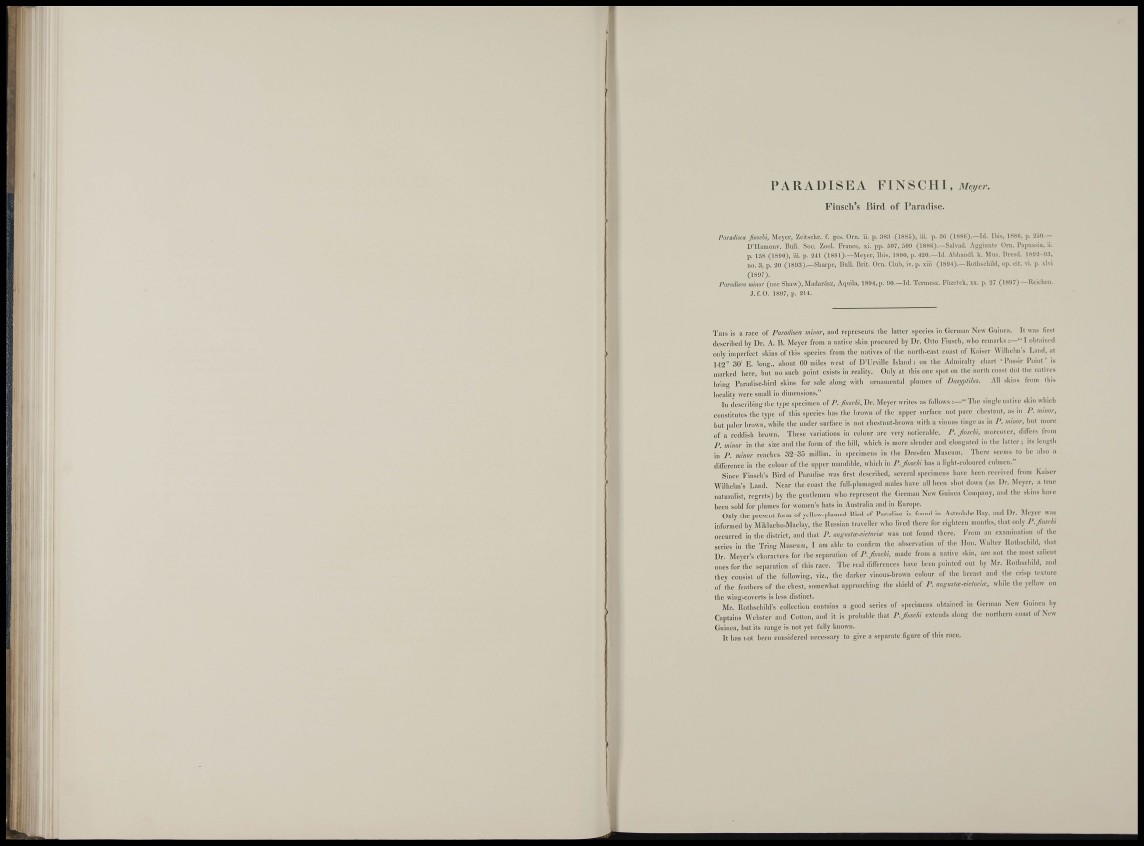
1 - r II
' f i l i , ^
III;
I ' f t i l ; ! ' ^
^ d i l : 'I
l ' l i ' : ' "
P A R A D I S E A F I N S C H I , Me^/er.
Finscli's Bird of Paradise.
Paradisea Jinschi, Meyer, Zeitschr. f. ges. Orn. ii. p. 38:i (1886), iii. p. 3(i (188(i).—Id. Ibis, 1880. ji. 2.i0.—
D'Hamoiiv. Bull. Soc. Zool. France, xi. pp. 507, .'501) (1880).—Salviul. Aggiunte Orn. I'apuasia, ii.
p. 158 (1890), iii. p. 241 (1801).—Meyer, Ibis, 1890, p. 420.—Id. Abhandl. k. Mus. Uresd. 1892-9;),
no. 3, p. 20 (1893).—Sharpe, Bull. Brit. Oru. Club, iv. p. xiii (1894).—Rothschild, op. cit. vi. p. xlvi
(1897).
Paradisea minor (nec Shaw), MadarSsz, Aquila, 1894, p. 90.—Id. Tcrmcsz. Fiizetck, xx. p. 27 (1897) —Reichcu.
J . f . O. 1897, p. 214.
THIS is a racc of Pariiduea minor, and rci)RCSEMTS tlie latter species in German New Guinea. It was first
described by Dr . A. 13. Meyer from a native skin procured by Dr . Otto Finsch, wlio remarks " I obtained
only imperfect skins of this species from the natives of the north-east coast of Kaiser Wilbelm's T.and, at
1 4 2 ° 30' E. long., about (iO miles west of D'Urville Island: on the Admiralty chart ' I'assir Point' is
marked here, hut no such iioint e.vists in reality. Only at this one spot on the norlli coast did the natives
bring I'liradise-bird skins for sale along with ornamental plumes of Dasyptilus. All skins from this
locality were small in dimensions."
In (lesci ibing the type specimen of P. finsch!. Dr. Meyer writes as follows " The single native skin which
constitutes the type of this s])ecies lias the lirown of the upper surface not pure clieslnut, as in I', minor,
hut paler brown, while the under surface is not chestnut-brown wilh a vinous tinge as in I', minor, but more
of a reddish brown. These variations in colour are very noticeahlc. P. Jinschi, moreover, dilfeis from
P. minor in the size aiid the form of the bill, which is more slender and elongated in the latter ; its length
i n ' P . minor reaches 32-35 millim. in siK'cimcns in the Dresden Museum. There seems to be also a
difference in the colour of the ii])i)er mandible, which in P. Jinschi has a light-coloured culineii."
Since Finsch's Bird of Paradise was first described, several sjiecimens ha\e hcen received from Kaiser
Wilbelm's Land. Near the coast the full-jilumaged males have all been shot down (as Dr. Meyer, a true
naturalist, regrets) by the gentlemen who represent the German New Guinea Company, and the skins have
been sold for plumes for women's hats in Australia and in Eurojie.
Only the present form of yellow-plumed Bird of Paradise is foiiiul in Astrolabe Bay, and Dr. Meyer was
informed by Miklucho-Maclay, the Uussian traveller who lived there for eighteen months, that o.ily P. Jinschi
occurred in the district, and that P. anguslai-ticiorice was not fouTid there. From an examination of the
series in the Tring Museum, I am able to confirm the oh.servation of the Hon. Walter Ilotliscbild, that
D r . Meyer's characters for the separation of P. Jinschi, made from a native skin, are not the most salient
ones for the separation of this race. The real dillerences have been pointed out by Mr. Rothschild, and
they consist of the followi.ig, viz., the darker vinous-brown colour of the breast and the crisii texture
of the feathers of the chest, somewhat ajiproaching the shield of P. angmtai-ticloriai, while the yellow on
the w i n g - c o v e r t s is less distinct.
Mr. Rothschild's collection contains a good scries of specimens obtained in German New Guinea by
Captains Webster and Cotton, and it is probable that P. Jinschi exte.ids along the northern toast of New
Guiiiea, but its range is not yet fully known.
I t has not been considered necessary to give a separate figure of this race.
É